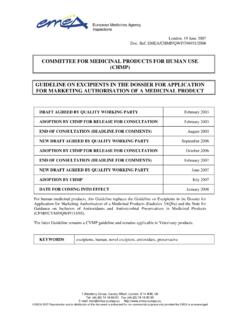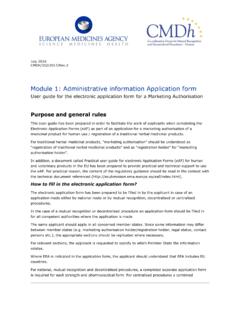Transcription of VOLUME 2A Procedures for marketing authorisation …
1 1 EUROPEAN COMMISSION HEALTH AND FOOD SAFETY DIRECTORATE-GENERAL Health systems and products Medicinal products Revision 11 NOTICE TO APPLICANTS VOLUME 2A Procedures for marketing authorisation CHAPTER 1 marketing authorisation July 2019 This Chapter 1 marketing authorisation will be included in The Rules governing Medicinal Products in the European Union The Notice to Applicants VOLUME 2A Procedures for marketing authorisation 2 CHAPTER 1 marketing authorisation CHAPTER 1 marketing authorisation .. 2 1. 3 Objectives .. 3 Status .. 3 2. marketing 4 National authorisations .. 6 Union authorisations .. 6 Notion of global marketing authorisation .. 8 Validity of the marketing authorisation .. 10 Name of a medicinal product .. 12 Transparency .. 13 Multiple applications .. 13 Concept of "applicant" and " marketing authorisation holder" .. 14 3. marketing authorisation Procedures .. 15 Centralised procedure .. 15 Decentralised procedure and mutual recognition procedure.
2 17 Procedure for homeopathic medicinal products .. 18 Procedure for traditional herbal medicinal products (traditional-use registration) .. 20 Paediatric requirements for medicinal products .. 22 Independent national Procedures .. 23 Procedures according to Article 126a of Directive 2001/83/EC .. 23 4. UNION REFERRALS .. 25 5. APPLICATION TYPES .. 27 Basic requirements .. 28 applications according to Article 8(3) of Directive 2001/83/EC .. 29 applications according to Article 10 of Directive 2001/83/EC .. 29 Application according to Article 10b of Directive 2001/83/EEC .. 39 applications according to Article 10c of Directive 2001/83 /EC .. 40 6. DATA EXCLUSIVITY AND MARKET PROTECTION .. 42 Data exclusivity and market protection period for reference medicinal products .. 42 Extension of the ten year period in Article 10(1) in the case of new therapeutic indications .. 46 One year period of protection for new indications of well-established substances.
3 47 One year period of protection for data supporting a change of classification 48 7. VARIATIONS AND 49 Urgent safety restrictions .. 49 8. PLASMA MASTER FILE PROCEDURE AND VACCINE ANTIGEN MASTER FILE PROCEDURE .. 50 ANNEX I DEFINITION OF A NEW ACTIVE SUBSTANCE .. 52 ANNEX II GUIDANCE ON THE APPROPRIATE ADDITIONAL STUDIES REQUIRED FOR applications UNDER ARTICLE 10 OF DIRECTIVE 2001/83/EC OR EXTENSION applications .. 53 3 1. INTRODUCTION Objectives The primary purpose of the rules governing medicinal products is to safeguard public health. However, this objective must be achieved by means which do not hinder the development of the pharmaceutical industry or trade in medicinal products within the Union. Thus, the pharmaceutical legislation of the European Union has consistently pursued the twin objectives: the protection of public health and the free movement of medicinal products. General principles of the Union pharmaceutical legislation are given in this chapter.
4 More detailed explanations concerning the different Procedures for marketing authorisation are provided in Chapters 2 - 6. Status This Notice to Applicants has been prepared in accordance with Article 6 of Regulation (EC) No 726/20041 and Annex I of Directive 2001/83/EC2 on the Community code relating to medicinal products for human use. It is intended to facilitate the interpretation and application of the Union pharmaceutical legislation. It is not legally binding and, in case of doubt, reference should be made to the appropriate Union Directives and Regulations. It is important when reading this text to appreciate that the legal requirements of the Union pharmaceutical legislation must be met and that this Notice to Applicants represents the harmonised view of the Member States, the European Medicines Agency (EMA) and the Commission services on how those requirements may be met.
5 Guidelines and other interpretative documents to which references are included within this document represent the views of their authors. References throughout the Notice to Applicants to provisions of Directive 2001/83/EC and Regulation (EC) 726/2004 must be read as references to the directive and the regulation as last amended3, unless it is otherwise expressly stated. 1 OJ L 136, , 2 OJ L 331, , p. 67. 3 Directive 2012/26/EU of the European Parliament and of the Council of 25 October 2012 amending Directive 2001/83/EC as regards pharmacovigilance, OJ L 299 of , p. 1 and Regulation (EU) No1027/2012 of the European Parliament and of the Council of 25 October 2012 amending Regulation (EC) No726/2004 as regards pharmacovigilance, OJ L 316 of 14/11/2012, p. 8. 4 2. marketing authorisation A medicinal product may only be placed on the market in the European Economic Area (EEA) when a marketing authorisation has been issued by the competent authority of a Member State for its own territory (national authorisation ) or when an authorisation has been granted in accordance with Regulation (EC) No 726/2004 for the entire Union (an Union authorisation ).
6 The marketing authorisation holder must be established within the EEA. Article 54 of the Treaty of the functioning of the European Union (Chapter 2 Right of establishment) reads: Companies or firms formed in accordance with the law of a Member State and having their registered office, central administration or principal place of business within the Union must, for the purposes of this Chapter, be treated in the same way as natural persons who are nationals of Member States. Companies or firms means companies or firms constituted under civil or commercial law, including co-operative societies, and other legal persons governed by public or private law, save for those which are non-profit-making . For the purpose of applying this definition in the context of the pharmaceutical legislation it should be clarified that non profit-making organisations can be marketing authorisation holders. A marketing authorisation lays down the terms under which the marketing of a medicinal product is authorised in the EU.
7 A marketing authorisation is composed of: (i) a decision granting the marketing authorisation issued by the relevant authority; and (ii) a technical dossier with the data submitted by the applicant in accordance with Articles 8(3) to 11 of Directive 2001/83/EC and Annex I thereto, Articles 6(2) and 31(2) of Regulation (EC) No 726/2004, or Article 7 of Regulation (EC) No 1394/2007. European Economic Area (EEA) Norway, Iceland and Liechtenstein form the EEA with the 28 Member States of the European Union. These countries have, through the EEA agreement, adopted the complete Union acquis on medicinal products and are consequently parties to the Union Procedures . Where in this chapter reference is made to Member States of the Union this should be read to include Norway, Iceland and Liechtenstein. Legally binding acts from the Union ( Commission decisions) do not directly confer rights and obligations but have first to be transposed into legally binding acts in Norway, Iceland and Liechtenstein.
8 According to Decision N 74/1999 of the EEA Joint Committee when decisions on approval of medicinal products are taken by the Union, Norway, Iceland and Liechtenstein will take corresponding decisions on the basis of relevant acts. Consequently, these States are concerned with the single European market for medicinal products. Therefore, where in Article 2 of Regulation (EC) No 726/2004 and Article 8 of Directive 2001/83/EC, reference is made to the applicant 5 being established in the Union, this is extended to include Norway, Iceland and Liechtenstein. The marketing authorisations granted by Norway, Iceland and Liechtenstein are eligible for the mutual recognition procedure in the same way as the marketing authorisations granted by Member States. Liechtenstein Since 1st December 2010 the treaty4 between Liechtenstein and Austria about automatic recognition of the marketing Authorisations granted via Mutual Recognition Procedure (MRP) or Decentralised Procedure (DCP) is operational.
9 This allows Liechtenstein to use marketing Authorisations granted by Austria provided the applicants have identified Liechtenstein as CMS in the application form submitted with MRP or DCP applications . At the end of the Procedures , Austria will grant authorisations that will be recognised by Liechtenstein. This marketing authorisation can be considered as a marketing authorisation granted in accordance with the pharmaceutical acquis for the purpose of EU legislation and in particular can be considered as a starting point for the purposes of data exclusivity/market protection in the EU. Further, in application of a bilateral agreement5 between Switzerland and Liechtenstein, a Swiss marketing authorisation is automatically effective in Liechtenstein. This recognition has no effects outside the customs union between Switzerland and Liechtenstein. Consequently a marketing authorisation granted by the Swiss authorities and recognised by Liechtenstein, while Switzerland does not apply the EU pharmaceutical acquis, cannot be considered as a marketing authorisation granted in accordance with the pharmaceutical acquis for the purpose of EU legislation and in particular cannot be considered as a starting point for the purposes of data exclusivity/market protection in the EU (see part 6 on data exclusivity/market protection).
10 Monaco An agreement between the Union and the Principality of Monaco entered into force on 1 May 2004, Council Decision 2003/885/EC of 17 November 2003 concerning the conclusion of the Agreement on the application of certain Community acts on the territory of the Principality of Monaco6. On the basis of this agreement and the special arrangements agreed between France and the Principality of Monaco in an agreement of 6 January 2003, the French authorities assume the role of competent authorities as far as the application of the medicinal products legislation to products manufactured in Monaco is concerned. The French authorities are responsible for the issue of marketing authorisations for Monaco and conduct inspections on manufacturing sites 41 Abkommen zwischen der sterreichischen Bundesregierung und der Regierung des F rstentums Liechtenstein betreffend die automatische Anerkennung von in sterreich zugelassenen bzw.














